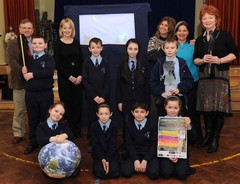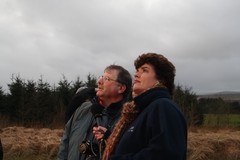Draconids Meteor Shower Event
Armagh Observatory opened its doors to the public on 8th October 2011. Despite a very wet evening when no meteors were observed members of the public turned up for the 2 lectures and to view the telescopes. Members of the IAA (Irish Astronomical Association) were in attendance for an additional talk and to show an actual meteorite. UNAWE activities were also provided for the children. These outreach activities took place during World Space Week and October 8th was also International Observe the Moon Night.
Joint event with EU-UNAWE Italian colleagues
During the BBC’s Stargazing LIVE in 2012 January, UNAWE staff at Armagh Observatory were joined by visiting UNAWE staff from the world famous Arcetri Observatory, Florence, Italy to provide a Shadow Theatre production on Galileo at Mt St Catherine’s Primary School Armagh. Over 100 children and their teachers took part in science experiments on sound waves and gravity as well as enjoying the production “Virginia and Galileo Galilei: a sky full of discoveries” by Italians Lara Albanese and Alessandra Zanazzi.
BBC Stargazing LIVE events 2012 January
On 17th January 2012 Armagh Observatory staff were working at the IAA's major BBC Two Stargazing Live event at Lough Neagh Discovery Centre promoting the work of the Observatory and EU-UNAWE. The IAA evening was a huge success and in spite of cloudy skies an official attendance figure of 1200 people was recorded.
The following day, (January 18th) Armagh Observatory, working with NIEA (NI Environment Agency) held a major Stargazing LIVE event at An Creagán and Beaghmore Stone Circles, Co Tyrone. Beaghmore is a unique megalithic site in Europe and the best Dark-Sky site in Northern Ireland. BBC Radio Ulster recorded an interview with Professor Bailey.
The event was also part of the Armagh Observatory’s programme of Science in the Community supported by the Department of Culture, Arts and Leisure (DCAL) through its Learning Strategy and by the Observatory's participation in EU-UNAWE. This is an international astronomy outreach programme funded by the European Community's Seventh Framework Programme (FP7/2007-2013) under grant agreement No. 263325.
Other partners in the event were Cookstown and Omagh District Councils and the NIEA, the agency that aims to protect, conserve and promote Northern Ireland’s natural environment and built heritage for the benefit of present and future generations.
Claire Foley, Senior Inspector of Built Heritage at NIEA, said "It is great to be part of this joint approach to our shared heritage; there is so much to learn from these fascinating Bronze Age monuments in our countryside dating back thousands of years, not just from studies on the ground but from the sky as well!"
Mark Bailey, Director of the Observatory, added: "Astronomy captures the imagination of children, young and old, as well as others young at heart. A view of the stars and of our Milky Way on a clear night from a Dark-Sky site such as Beaghmore can be an awe-inspiring, sometimes life-changing experience. Bringing the Heavens down to Earth in this way as part of EU-UNAWE encourages global awareness amongst all age groups and highlights an influence that has affected all societies and cultures throughout human history: that is, Earth’s place in space and our shared experience of living under the same sky.”
Stargazing LIVE at An Creagán and Beaghmore had three components. In the morning, 53 local primary school children undertook a series of astronomy and science-based activities at An Creagán, including those that illustrate the lives of the people that built the stone circles at Beaghmore, in those early times. There were also hands-on EU-UNAWE activities to illustrate the scale of our Solar System, and a fascinating shadow theatre provided by EU-UNAWE presenters from the world-famous Arcetri Observatory in Florence, Italy. The play introduces Virginia, Galileo's daughter, and her imagined responses to the new world-view being discovered and promoted by her father following his first use of the telescope in 1609 to look at the stars. It has been produced thanks to the practical contributions and ideas of the famous puppet-maker and shadow theatre expert Mariano Dolci.
Later, approximately 115 children and adults attended a free Stargazing LIVE event at Beaghmore from 3.30pm to 5.00pm. Living History enactors greeted them and demonstrated Bronze Age weapons and artefacts technology, including food and agriculture, highlighting possible reasons for the need to use astronomy and the science behind the circles’ original purpose. There were also opportunities to view the stones at sunset and observe the bright planets Venus and Jupiter, both visible as evening "stars" after sunset, and other stars.
The last part of the event, from 8.00pm to 9.30pm, comprised of two public lectures, with 85 people in attendance, the first by Claire Foley (NIEA) entitled "Stone Circles and the Bronze Age Perception of the Skies", and the second by Mark Bailey (Armagh Observatory) entitled "Comets and Cometary Concepts in History: Identifying the Celestial Connection".
Live Radio Broadcast on 27th January 2012
Staff from Armagh Observatory took part in a 2-hour live astronomy programme on Radio Ulster on the evening of Friday 27 January from Delamont Country Park, near Killyleagh, Co Down. This IAA event had a large selection of powerful telescopes and binoculars for viewing the sky, plus the Stardome mobile planetarium. Due to pristine clear skies the event was a huge success!
Observatory staff spoke of their work, love of astronomy and projects they were working on including EU-UNAWE



















